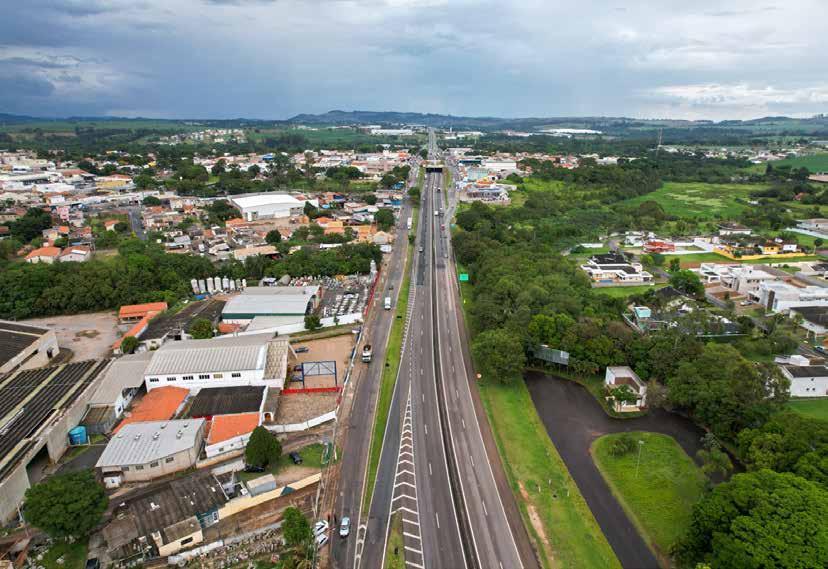
2 minute read
A fundação
A fundação da cidade de Cabreúva é datada do início do século XVIII. Foi a ocupação do vale entre as serras do Japi, Guaxatuba, Guaxinduva, Cristais e Taguá que deu origem à cidade. A família Martins e Ramos iniciou na região o cultivo de cana-de-açúcar para a fabricação de aguardente, o que fez com que muitos engenhos se instalassem na localidade, fazendo com que Cabreúva ficasse conhecida como a “terra da pinga”. Inicialmente, Cabreúva era apenas um distrito da cidade de Itu, passando a ter sua autonomia em 24 de março de 1859.
O nome Cabreúva vem da árvore kaburé-iwa, que significa “árvore da coruja”. Quando os ituanos se dirigiam para onde hoje é o município, passavam por uma pequena ponte improvisada (pinguela) sobre um pequeno riacho. Essa ponte era uma árvore Cabreúva, e o pequeno riacho é, hoje em dia, o ribeirão Cabreúva.
Advertisement
Destaque nacional
Cabreúva é destaque nacional, ocupando a 43ª colocação entre as melhores cidades de pequeno porte do Brasil, segundo a Revista Istoé. Em parceria com a consultoria Austin Rating, a Editora Três, que publica a revista, chegou a essa conclusão a partir do Índice de Inclusão Social e Digital


(IISD), utilizado pela Austin Rating. O Índice analisa 281 indicadores, que abrangem os setores social, fiscal, econômico e digital. Como base para essa análise são avaliados os índices que os municípios apresentam nos órgãos confiáveis, como os do Instituto Brasileiro de Geografia e Estatística (IBGE) e do Ministério da Saúde; entre outros.
Em contato com a natureza
Com uma localização privilegiada, cercada por vales verdejantes, Cabreúva figura como um excelente destino para quem procura viver em contato com a natureza. Seu território abrange mais de 40% da área da Serra do Japi, importante reserva biológica de preservação da mata atlântica no interior do Estado de São Paulo. O local é notoriamente conhecido por possuir uma rica diversidade de espécies da nossa flora e fauna. Cabreúva também é conhecida por atrair muitas pessoas para o seu turismo rural, com campings, turismo religioso, bem como pelo cicloturismo.
The foundation of the city of Cabreúva dates back to the beginning of the 18th century. It was the occupation of the valley between the Japi, Guaxatuba, Guaxinduva, Cristais and Taguá mountains that gave rise to the city. The Martins e Ramos family started growing sugar cane in the region to make brandy, which led to the establishment of many mills in the area, making Cabreúva known as the “land of pinga”.

Initially, Cabreúva was just a district of the city of Itu, starting to have its autonomy on March 24, 1859.
The name Cabreúva comes from the kaburé-iwa tree, which means “owl tree”. When Itu citizens went to what is now the municipality, they would cross a small improvised bridge (pinguela) over a small stream. That bridge was a Cabreúva tree, and the small stream is, nowadays, the Cabreúva stream.
National highlight
Cabreúva is a national highlight, occupying the 43rd place among the best small cities in Brazil, according to Istoé Magazine. In partnership with the consultancy Austin Rating, Editora Três, which publishes the magazine, reached this conclusion based on the Social and Digital Inclusion Index (IISD), used by Austin Rating. The Index analyzes 281 indicators, spanning the social, fiscal, economic and digital sectors. As a basis for this analysis, the indices that the municipalities present in reliable bodies, such as those of the Brazilian Institute of Geography and Statistics (IBGE) and the Ministry of Health, are evaluated; among others.

In touch with nature
With a privileged location, surrounded by green valleys, Cabreúva is an excellent destination for those looking to live in contact with nature. Its territory covers more than 40% of the Serra do Japi area, an important biological reserve for the preservation of the Atlantic Forest in the interior of the State of São Paulo. The place is famously known for having a rich diversity of species of our flora and fauna. Cabreúva is also known for attracting many people to its rural tourism, with camping sites, religious tourism, as well as bike tourism.







